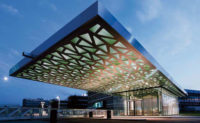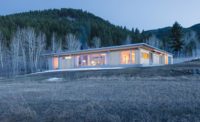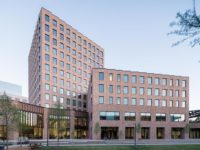The buildings that line Interstate 90 in Illinois are typically undistinguished, banal, light-industrial boxes and chain motor inns. The Trumpf Smart Factory, just northwest of Chicago’s O’Hare International Airport, defies that convention with its bold use of corrugated, rust-colored Corten steel sheets and glass for a facility designed by the firm of Barkow Leibinger. Trumpf, a German company, is not a new client for the Berlin-based architects, who developed the master plan for Trumpf’s Stuttgart campus from 1997 to 2010. But the gently rolling plains of northern Illinois are a new landscape for principal Frank Barkow, a Montana native. “It’s so beautiful,” he says while describing how the building’s simple figure-eight plan, organized under a single shed roof, is oriented to align with the highway along its front and to overlook the gently sloping wetlands to the rear.
When we visited on a September afternoon, sunlight flooded the double-height entry lobby, a generous space created where the building’s two volumes overlap at one corner. The north volume, housing offices and support spaces, wraps around a gravel-lined courtyard planted with a variety of young trees. Exposed steel beams and metal grating run across the pitched ceiling, and charred Douglas fir softens the walls. The larger, southern volume, where Trumpf’s metal-cutting machinery is installed in a factory setting, follows the “industrial logic of section versus plan,” according to Barkow. In the tradition of natural day-lighting in factories, floor-to-ceiling glazing clads the long north and south facades—and, of course, the space is column-free. The detail is in the section, which is animated by the depth of eleven customized Vierendeel trusses that span 45 meters. They support a catwalk running the length of the showroom, and giving views of the machines below.
The unique trusses, which bend to accommodate the sloping shed roof, consist of steel parts laser-cut on Trumpf machines, welded together, and trucked up from Atlanta for installation. The use of Trumpf technology to build the company’s buildings is, Barkow says, another way to show the firm’s technical know-how. In Illinois, the use of steel and Corten is also in keeping with the American modernist approach firmly established in the Midwest by Mies van der Rohe and Eero Saarinen in the 1950s and ’60s. Thin steel columns along the glazed factory walls, added for wind bracing, recall the applied steel columns in Mies van der Rohe’s 860—880 and 900—910 Lake Shore Drive apartments completed in 1949 and 1955 in Chicago. The use of Corten echoes the materials in Saarinen’s John Deere Headquarters in Moline, Illinois (1964), where there is also a tall, glazed showroom for farm equipment with overhead walkways for viewing the machinery on display below.
For architectural cognoscenti, these references are clear, but for employees and customers, the Trumpf Smart Factory is simply a handsome, flexible building that, in its low profile and choice of materials, pays homage to its landscape—a terrace to the rear of the lobby even provides views and access to the wetlands—and to its owner-occupant. Walking across the catwalk suspended between the robust trusses, Barkow spoke of the recently completed building as almost a work in progress: “Look, it can be expanded by popping off the end and adding trusses,” he said.









Post a comment to this article
Report Abusive Comment